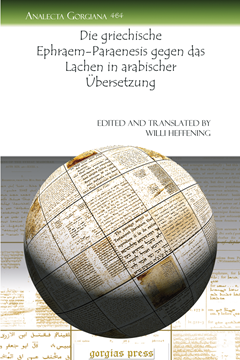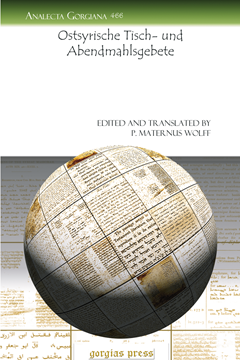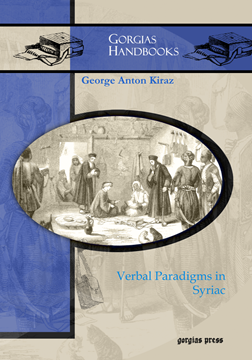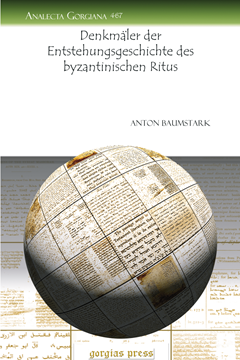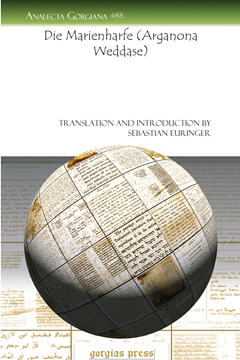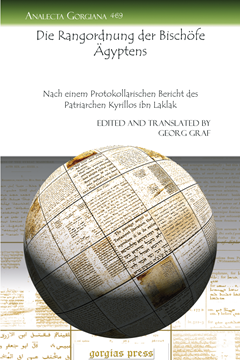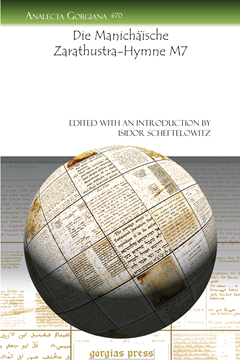Die griechische Ephraem-Paraenesis gegen das Lachen in arabischer Übersetzung
Edited and Translated by Willi Heffening
Series: Analecta Gorgiana 464
ISBN: 978-1-60724-917-7
Willi Heffening publishes here the Arabic version of the “sermon against laughter” attributed to Ephrem. Heffening accompanies the Arabic text with a brief introduction, a German translation, and a critical apparatus with variants from the Greek version.
$37.00 (USD)
Die Chronik des Eusebius in der syrischen Überlieferung
Series: Analecta Gorgiana 465
ISBN: 978-1-60724-918-4
In the present study, Paul Keseling surveys the use of the Chronicle of Eusebius in later Syriac historical works, such as the “Epitome of Syria” and the chronicles of Pseudo-Dionysius, Elias of Nisibis and Michael the Great.
$46.00 (USD)
Ostsyrische Tisch- und Abendmahlsgebete
Edited and Translated by P. Maternus Wolff
Series: Analecta Gorgiana 466
ISBN: 978-1-60724-919-1
P. Maternus Wolff publishes here the text and German translation of twenty Eucharistic prayers from the Syraic tradition. Wolff also includes an apparatus containing critical notes and an introduction in which he discusses several unique features of these prayers.
$36.00 (USD)
Dating Archaic Biblical Hebrew Poetry
A Critique of the Linguistic Arguments
ISBN: 978-1-61143-921-2
The dating of some Archaic Biblical Hebrew poems to the late second millennium – early first millennium BCE on the basis of a handful of linguistic forms in common with second millennium Ugaritic and Amarna-Canaanite texts is brought into question. This critique highlights the problems with the arguments and hypotheses presented in the literature, and concludes that there is no compelling evidence to support the use of linguistic data for dating purposes.
$158.00 (USD)
Verbal Paradigms in Syriac
Series: Gorgias Handbooks 16
ISBN: 978-1-60724-920-7
This handbook tabulates the most common verbal paradigms and conjugations. It begins by explaining the various types of verbs and how they differ from each other. Every table is spread over two pages in width. Columns and rows are marked to make easy references.
$38.00 (USD)
Hugoye - Journal of Syriac Studies (volume 13)
2010 [2011]
Series: Hugoye: Journal of Syriac Studies 13
ISBN: 978-1-60724-921-4
Widely regarded as a premier journal dedicated to the study of Syriac, Hugoye: Journal of Syriac Studies was established in 1998 as a venue devoted exclusively to the discipline. An organ of Beth Mardutho, the Syriac Institute, the journal appears semi-annually and will be printed in annual editions. A peer-reviewed journal, Hugoye is a respected academic source for up-to-date information about the state of Syriac studies and for discovering what is going on in the field. Contributors include some of the most respected names in the world of Syriac today.
$75.00 (USD)
Denkmäler der Entstehungsgeschichte des byzantinischen Ritus
Series: Analecta Gorgiana 467
ISBN: 978-1-60724-922-1
Anton Baumstark surveys key developments in the Byzantine liturgical rite and attempts to view these developments within the historical circumstances that likely affected or caused them.
$38.00 (USD)
Die Marienharfe (Arganona Weddase)
Translation and Introduction by Sebastian Euringer
Series: Analecta Gorgiana 468
ISBN: 978-1-60724-923-8
Sebastian Euringer publishes here a German translation of the Ethiopic text of a grand poem dedicated to the Virgin Mary from the “monophysite” tradition. Euringer accompanies the translation with an introduction and critical notes.
$77.00 (USD)
Die Rangordnung der Bischöfe Ägyptens
Nach einem Protokollarischen Bericht des Patriarchen Kyrillos ibn Laklak
Edited and Translated by Georg Graf
Series: Analecta Gorgiana 469
ISBN: 978-1-60724-924-5
Georg Graf publishes here the Arabic text and German translation of a “protocol report” by Cyril ibn Laklak, an important historical source for the study of the life of Cyril and for the history of Egyptian bishops.
$39.00 (USD)
Die Manichäische Zarathustra-Hymne M7
Edited with an Introduction by Isidor Scheftelowitz
Series: Analecta Gorgiana 470
ISBN: 978-1-60724-925-2
In the present article, Isidor Scheftelowitz challenges the conclusions of Richard Reitzenstein that a Manichaean hymn fragment contained influences from the old Iranian religious system by offering a new translation and texts for comparison.
$36.00 (USD)
